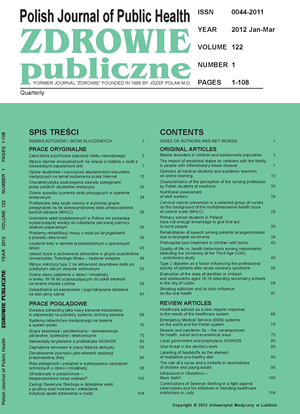Characteristics of the perception of the nursing profession by Polish students of medicine
Keywords:
medical students, nurses job, professional roles, PNIS questionnairesAbstract
Introduction. The extent of mutual collaboration between physicians and nurses can be influenced by ascribed social roles and cultural standards.
Aim. The objective of the study is the presentation of medical students’ opinions concerning the perception of the nursing profession, and an attempt to determine the factors conditioning this perception.
Material and methods. The studies of a descriptiveexplanatory character were conducted with the use of the Professional Nursing Image Survey, and covered a group of 900 medical students from three universities in Poland. The results were subject to mathematical analysis with the use of basic software.
Results. The statistical analysis of the results of studies confirm previously observed determinants of the perception of the professional role of a nurse by physicians, i.e. gender and, to a smaller degree, student’s period of training (year of study). Conclusion. Medical students in Poland believe that the Polish nurses’ ways of therapeutic performance restrict their way to more independent practice. Analysis of the opinion of medical students on the nursing profession can contribute to the greater autonomy of professional nurses.
Practice implications. The perception of nurses’ professional role may be determined by social and cultural factors but also through cooperation in education of medical and nursing students.
References
1. Tymowska K. Health care under transformation in Poland. Health Policy. 2001;56:85-98.
2. Sztembis B. The past, present and future of nurse education in Poland: stages, conditions and activities. Int Nur Rev. 2006;53:102-9.
3. Hempel E. Change in perspective. ONE`s profession from the viewpoint of others: how do nurses feel they are being perceived by physicians in professional interactions? Pflege. 2003;16:297-303.
4. Hojat M, Gonnella JS, Nasca TJ, Fields SK, Cicchietti A, Lo Scalzo A, Toroni F., Amicosante AMV, Macinati M, Tangucci M, Liva C, Riccardi G, Eidelman S, Admi H, Geva H, Mashiach T, Alroy G, Alkorta-Gonzalez A, Ibarra D, Torres-Ruiz A. Comparisons of American, Israeli, Italian and Mexican physicans and nurses on the total and factors scoresof the Jefferson scale of attitudes toward physican-nurse collaborative relationships. Inter J Nu Stud. 2003;40:427-35.
5. Wrońska I. Rola społeczno - zawodowa pielęgniarki. Studium z zakresu współczesnego pielęgniarstwa. Warszawa: CEM; 1997.
6. Zelek B, Philips PS. Gender and power: Nurses and doctors in Canada. Inter J Equity Health. 2003;2:8-11.
7. Januszewicz P, Zarzycka D, Bińkowska-Bury M, Marć M, Zalewska K. Nurses and doctor – prognosis on the future. Przeg Lek. 2009;66:55-6.
8. Fealy GM. ‘The good nurse’: visions and values in images of the nurse. JAN. 2002;46: 649-56.
9. Parsell G. Interprofessional learning. Postgraduate Med J. 1998;74:89-95.
10. Richards A, Carley J, Jenkins-Clarke S, Richards DA. Skill mix between nurses and doctors working in primary care - delegation or allocation? A review of the literature. Inter J Nur Stud. 2000;37:185-97.
11. Fagin CM. Collaboration between nurses and physicians: No longer a choice. Acad Med. 1992;67:295-303.
12. Hojat M, Nasca TJ, Cohen MJM, FieldsI SK, Rattner SL, Griffiths M, Ibarra D, De Gonzalez AAG, Torres-Ruiz A, Ibarra G, Garcia A. Attitudes towards physician-nurse collaboration: A cross-cultural study of male and female physicians and nurses in the United States and Mexico. Nur Res. 2001;50:123-8.
13. Foley M, Jacobson L, Anvapiour PL. Second-year medical students’ perceptions of the professional nurse’s role. Journal of the New York St. Nur’ Assoc. 1995;26(2):15-9.
14. Lee M, Coulehan JL. Medical students` perceptions of racial diversity and gender equality. Med Educ. 2006;40:691-6.
15. Snelgrove S, Hughes D. Interprofessional relations between doctors and nurses: perspectives from South Wales. JAN. 2000;31:661-7.
16. Takase M, Maude P, Manias E. Impact of the perceived public image of nursing on nurses’ work behaviour. JAN. 2006;53:333-43.


